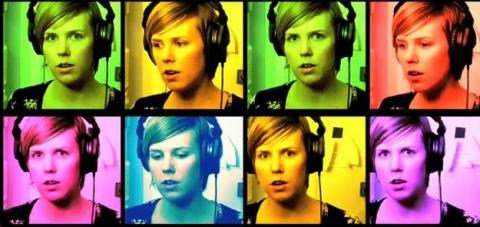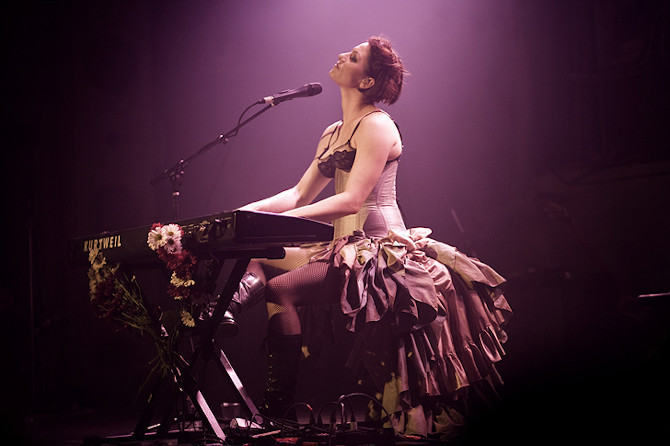Patreon: Portrait of the Artist in a Digital Economy

In its own words, the crowdfunding platform website Patreon “is empowering a new generation of creators to make a living from their passion and hard work.” The “living” part is what’s key here: Unlike other popular Internet crowdfunding sites – KickStarter, Indiegogo, GoFundMe, etc. – which aim to draw support for one-time projects or business launches, Patreon, founded in 2013, wants to find a way for independent artists (which, in this case, run the gamut from painters to video game critics to musicians) to garner a continuous stream of revenue – what others of us might call a stable income.
It goes without saying that the Internet and digital software have radically changed the ways we consume, create, and interact with art, not least of all music. It’s no wonder then that Patreon was co-founded by a financially-frustrated musician: Jack Conte, one-half of the duo Pomplamoose, themselves early pioneers in the viral-video potential of YouTube. But ad-based revenue, Conte explains, wasn’t earning the band nearly enough money to cover the costs of their production, let alone basic living expenses.
Though digital and Web technologies allowed Pomplamoose and other DIY (“Do-It-Yourself”) artists like them to bypass the rigmarole of the record-label-industrial-complex, distributing their work directly to their fans, a crucial step in the exchange of commodities goes missing in free and open content platforms like YouTube: The fans have no way to give back to the artists, no way to pay for the goods they’ve received, even if they want to.
Part of the issue in negotiating digital content is its intangibility. Unlike a record, a CD, a book, or an oil painting, we can’t fork over our cash and receive a physical item in return; it’s difficult to ascribe value to something that, on the one hand, has no tangible essence and, on the other hand, is infinitely replicable. This has proven particularly problematic in the music industry, where, Conte explains in an interview, the old model was “built around putting your art on a ‘thing’ and sending that ‘thing’ to consumers around the world. […] Now that we have the option of sending ‘things’ out for free, we have to decide how artists are going to get paid if we can’t actually sell the ‘thing’ anymore.”
Streaming services like Spotify, Rhapsody, and Tidal have tried to move in where record sales have slipped off, but nearly any report shows just how dismally artists get paid per play with these platforms. Moreover, revenue in this way is only generated from royalty payments – meaning artists can only hope to recoup the money spent making, recording, mixing, distributing, and promoting an album or single well after the investments have already been made. Traditionally – at least throughout most of 20th century popular music-making – this is where record labels come in, providing artists with an advance to cover their costs of production.
Working with a label, however, often comes with its own set of limitations, requiring artists to relinquish a certain amount of control over the creative, aesthetic, and financial decisions regarding their work. The beauty of the Internet – indeed, part of its basic founding promises and principles – is that it allows creators of all stripes to bypass that messy middleman, to deliver content and exchange information directly with other people all across the globe, unfettered and more or less uncensored.

Navigating intellectual property rights in digital waters hasn’t been easy. The loss of the ‘thing’ is an ongoing struggle in the exchange of cultural commodities, but it isn’t an unprecedented one. Patreon, in Conte’s words, borrows from a model of support used “before the ‘thing’ existed”: the patronage system. But you’ll not likely find any members of the Medici family on its site; unlike patronage of old, a one-way stream of funds from wealthy individuals to struggling artists, Patreon combines patronage with the ethos of crowdfunding (or, in perhaps more musically relevant terms, busking). Anyone can pledge $1 or more to creators of their choice, and the amount is paid automatically either every month or every time a new work is released. Small streams in this way can add up to a sizable flow: Pomplamoose’s own Patreon page, for instance, now pulls in $6,730 every time they release a new music video.
The democratization of the fundraising process offers greater creative autonomy to artists because they aren’t directly responsible to any one money-wielding boss. They are, however, accountable to each and every one of their patrons, who, at the same time, are provided with ways to become significantly involved in the creative process. Some artists even offer perks – video conferences, personalized work, special packages – to fans who contribute donations at $5, $10, or $50 tiers.
This kind of network appears to be a real boon for niche-level artists, those who have a loyal following of fans but whose appeal isn’t mainstream enough for major labels. Perhaps the shining exemplar of this is musician Amanda Palmer, whose “punk cabaret” genre and work as one-half of the Dresden Dolls isn’t exactly for everybody – but for some people, it’s their everything. After struggles with multiple labels both major and indie, Palmer joined Patreon in March 2015 and quickly became the site’s most highly-funded creator, with nearly 5,500 patrons contributing a combined $34,500 for every ‘thing’ she releases. As she explains on her own page:
i don’t find it as inspiring to work for two years on a bunch of songs, knowing that [i'm] going to have to spend TONS of time raising funds for a record, a few more months (or years, in some cases) going through the record-biz “album cycle”…..dude, it’s boring. i mean, all respect to the artists who do it, and i may choose to do it with one project or another, but mostly, f**k it, i just want to MAKE STUFF AND PUT IT OUT. and get paid, and then keep going. […] i like fast, now, bam. getting paid for doing things Fast Now Bam is usually impossible. now, patreon.
Palmer puts faith in what she calls an “honor system” between herself and her fans: If they like what she does, they will give her money to keep doing it. It’s not necessarily about circumventing downloads or putting a stop to pirating; as Conte explains, “You’re not saying ‘Hey, you can’t see my stuff unless you pay me.’ You’re saying, ‘Hey, I’m making stuff anyway – […] will you pay me a buck every time I make something?”
It might all sound utopian, even naively idealistic. And in many ways, it is: it goes against the entire hit-making record industry model. With most major labels, only the huge megastars – the Beyoncés and Taylor Swifts – really earn the company any revenue, which in turn helps cover the costs of trying to find and fund new talent (most of whom end up commercial failures) in hopes of finding the next superstar and continue the process.

Patreon doesn’t cater to major celebrities, nor should it. It’s not a means of replacing the old record industry model; it’s a parallel alternative. It’s a means of sustainability, and not necessarily a trajectory toward fame and fortune. As Conte states explicitly, “The point of all this is that we don’t need to be stars. It’s not about the fame or the massive appeal. It’s about the small business class.”
Mixing art and commerce might sound unsavory to purists who still believe in “art for art’s sake,” but it’s increasingly a stark reality creators must face in pursuit of the kinds of truth and beauty we as consumers expect to derive from art itself. The emphasis on creative autonomy in Patreon’s model is valuable for allowing the various arts represented on its pages room for growth and exploration, but we must also be careful that such independence doesn’t begin to stray too far down the path of hyper-individualism. The stress on the “self” in the DIY ethos risks losing sight of the fact that the power of crowdfunding and of the digital artistic economy can only be as strong as its community.
The artists who succeed with Patreon will be the ones who open wide the lines of communication in both directions. As Amanda Palmer writes to her fans:
here's the key: THIS IS A HUGE EXPERIMENT.
we can keep tweaking this as we go. […]
this is a platform where we can be in constant communication.
It’s the “we” that has kept Palmer afloat over the decades of her career, and it’s the “we” that will continue to determine the value and position of the artist in society, especially as that society grows increasingly composed of ones and zeros.
Author Bio:
Sandra Canosa is Highbrow Magazine’s chief music critic.
For Highbrow Magazine
Photo Credit: DeSha Metschke (Wikipedia.org, Creative Commons)






























































































































































































































































































































